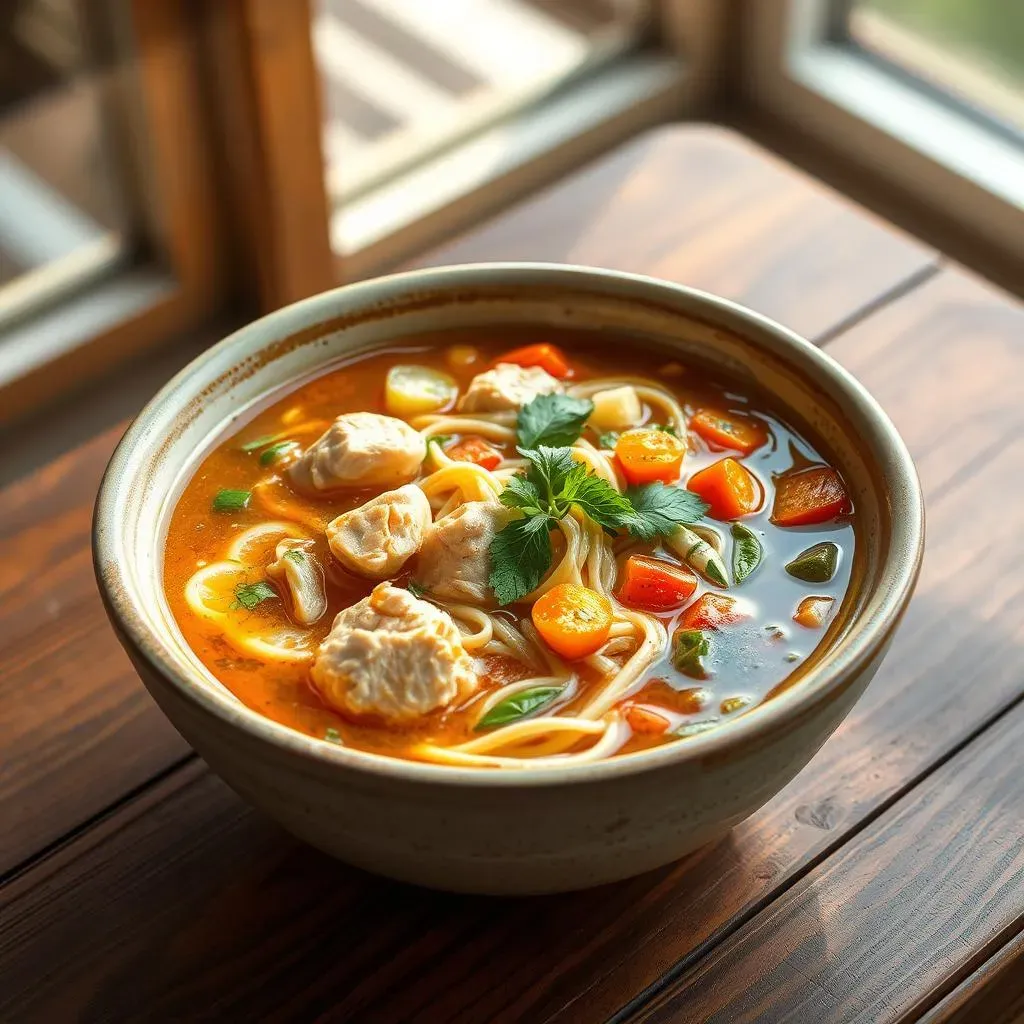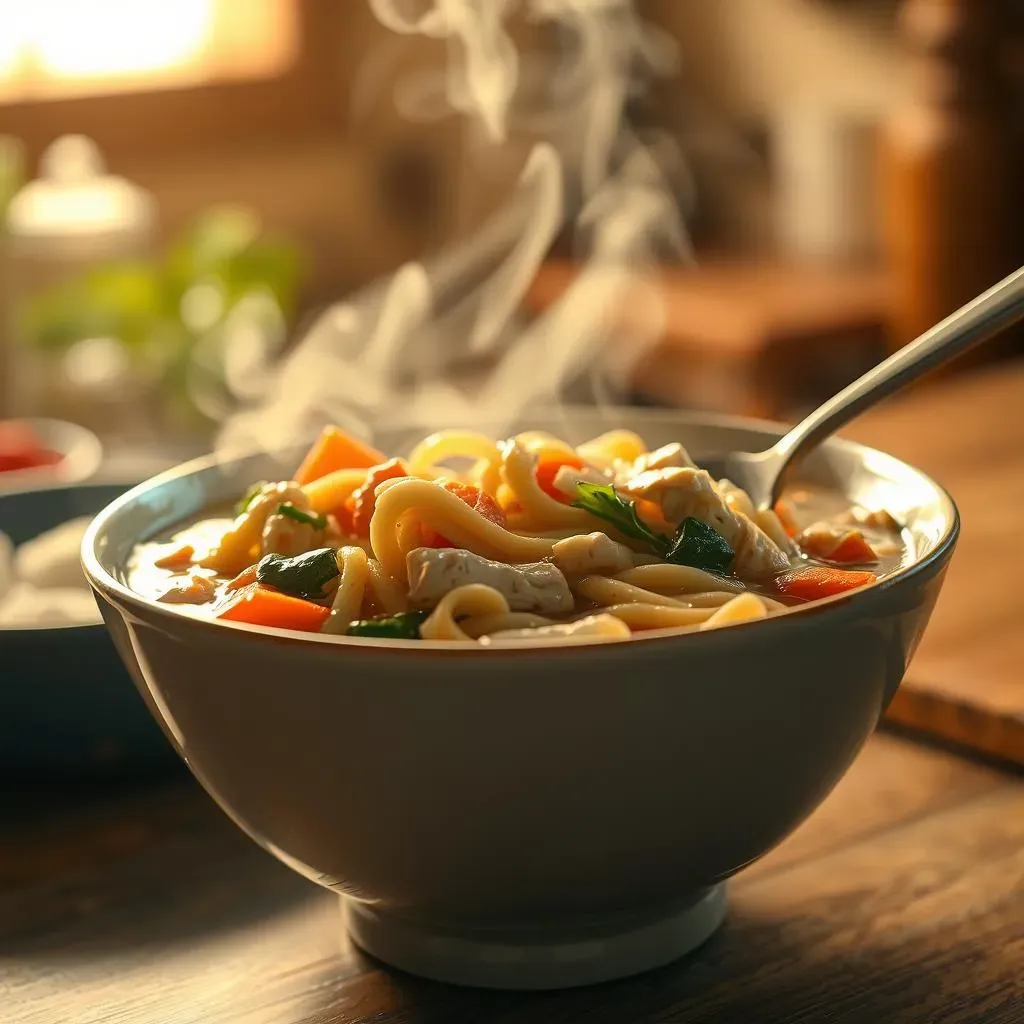Table of Contents
Ever found yourself reaching for that familiar red and white can on a chilly day? Chicken noodle soup, a staple in many households, often gets a reputation as the go-to comfort food when you're feeling under the weather. But the question lingers: is can chicken noodle soup healthy? It's easy to assume it's a nutritious option, packed with chicken, veggies, and noodles, but the reality of canned soup can be a bit more complicated. We're going to explore the truth about what's actually inside those cans and figure out if they're truly good for us. This isn't about trashing a beloved classic, but rather about making informed choices. We'll look at the sneaky sodium levels, the types of fats, the lack of fiber, and the difference between homemade and store-bought versions. We'll also provide some tips and tricks to make your next bowl of chicken noodle soup a bit more healthy. So, let's get real about what's swimming in that broth and discover how to make this classic dish work for you.
Is Can Chicken Noodle Soup Healthy? The Truth About Canned Soup

Is Can Chicken Noodle Soup Healthy? The Truth About Canned Soup
let’s talk about that can of chicken noodle soup sitting in your pantry. It's often seen as a quick fix, a warm hug in a bowl, especially when you’re feeling a bit under the weather. But is it really as healthy as we think? The truth is, it’s a mixed bag. Canned chicken noodle soup can be a convenient option when time is short or you need something easy to eat, but it’s not exactly a nutritional powerhouse. We're not saying it's the devil, but it's not a health food either. The problem often lies in the processing, the ingredients, and the way it's made. So, before you grab that can next time, let’s take a closer look at what's actually inside.
Sodium, Fat, and Fiber: Navigating the Nutritional Maze of Canned Soups

Sodium, Fat, and Fiber: Navigating the Nutritional Maze of Canned Soups
The Sodium Sneak Attack
let’s talk sodium. Canned soups are notorious for being salt bombs, and chicken noodle is no exception. It's like they're trying to preserve the soup for a thousand years, but your body doesn't need that much salt. All that sodium can lead to some serious health issues down the road, like high blood pressure. It’s not just a little sprinkle either; we're talking significant amounts in a single serving. You might not even realize how much you're consuming because it's hidden in the broth. It’s kinda like a ninja, sneaking up on you when you least expect it. So, next time you pick up a can, take a peek at the sodium content; it might just surprise you.
And it's not just about the sheer amount of sodium; it's also about the type. The sodium in canned soup often comes from processed salt, which isn’t as good as naturally occurring sodium in whole foods. Plus, the high sodium levels often mask the actual flavor of the soup, making it taste overly salty and kinda one-dimensional. It's like they’re using salt to compensate for a lack of real flavor. It's a bit of a bummer, because you think you’re getting a comforting bowl of goodness, but you might be getting more than you bargained for.
Nutrient | Typical Canned Soup Amount (per serving) | Recommended Daily Intake |
|---|---|---|
Sodium | Varies (often 400mg - 800mg) | Less than 2300mg |
Total Fat | Varies (often 5g - 10g) | 20% to 35% of total calories |
Fiber | Varies (often 1g - 3g) | 25-30g |
Fat and Fiber Follies
Now, let's move on to fat. The fat content in canned chicken noodle soup can be a bit tricky. You might think it's all lean chicken, but sometimes they use dark meat or add oils, which can bump up the fat and calorie count. And, not all fats are created equal; some can be less than ideal for your heart. It’s like a secret mission to add extra calories without you noticing. Then there's the fiber situation; or rather, the lack thereof. Canned soups often skimp on the veggies, which means they are usually pretty low in fiber. Fiber is like the broom for your digestive system, it keeps everything moving smoothly. Without it, you might find yourself feeling sluggish and not so great.
And don't even get me started on the noodles. Most canned soups use white pasta, which is basically a fiber desert. It’s like eating a bowl of simple carbs without much nutritional value. It’s not that white pasta is evil, but it's not doing you any favors in the fiber department. So, when you're choosing a can of chicken noodle soup, it's important to consider the whole picture; the salt, the fat, and the fiber. It's not as simple as picking a can off the shelf, you've got to be a bit of a detective.
- Check the sodium: Look for low-sodium or reduced-sodium options.
- Watch the fat: Opt for soups with lower fat content, especially saturated fat.
- Boost the fiber: If you can, add extra veggies or a whole-grain side.
Making Chicken Noodle Soup Healthier: Tips and Tricks

Making Chicken Noodle Soup Healthier: Tips and Tricks
Homemade is the Hero
Alright, so you're not doomed to a life of salty, low-fiber soup. The best way to control what goes into your bowl is to make it yourself. I know, I know, it sounds like a lot of work, but it's actually pretty simple, and you get to be the boss of your soup. When you make it at home, you can choose low-sodium broth, lean chicken, and load up on veggies. It's like creating your own superhero soup, tailored to your nutritional needs. Plus, it tastes way better than anything you'll find in a can. Trust me, your taste buds and your body will thank you.
Think of it like this: canned soup is like a mass-produced action figure, it's okay, but it's not unique. Homemade soup, on the other hand, is like crafting your own masterpiece, each ingredient carefully selected and added with love. You can use whole-wheat noodles, which give you that fiber boost, and add whatever veggies you like, from carrots and celery to spinach and mushrooms. It's your kitchen, your rules. And the best part? You know exactly what's going into your body, no hidden sodium ninjas or sneaky fats.
Smart Swaps and Savvy Strategies
Even if you're short on time and can't always make soup from scratch, there are still ways to make canned soup healthier. First, always go for the low-sodium or reduced-sodium versions. It's a small change that makes a big difference. Then, consider adding your own veggies to the canned soup. Throw in some frozen peas, carrots, or spinach to boost the fiber and nutrients. It's like giving your soup a nutritional upgrade, and it's super easy. You can also add a bit of lean protein, like shredded chicken breast, to make it more filling and satisfying.
Another trick is to drain and rinse the noodles in the canned soup before you heat it up. This helps to reduce some of the sodium. It's not a perfect solution, but it's a step in the right direction. And, if you're feeling adventurous, experiment with different herbs and spices to add flavor without adding extra salt. Things like garlic powder, onion powder, and black pepper can make a big difference. It's like giving your soup a flavor makeover, making it taste better and be better for you. Remember, small changes can add up to big improvements over time. You don't need to be a gourmet chef to make healthier choices.
The Bottom Line: Making Informed Choices About Chicken Noodle Soup
So, is can chicken noodle soup healthy? The answer, like most things, isn't a simple yes or no. Canned versions can be a quick and convenient option, but they often come with a hefty dose of sodium, less-than-ideal fats, and a lack of fiber. The key takeaway is to be mindful of what you're putting into your body. Reading labels, opting for low-sodium choices, and adding your own fresh veggies can make a big difference. And, of course, making your own from scratch gives you the ultimate control over ingredients and nutritional content. This isn't about giving up the comfort of chicken noodle soup; it’s about making smarter choices that align with your health goals. So, next time you reach for that can, remember to consider all the factors we've discussed and choose what's best for you. After all, a little awareness goes a long way in enjoying this classic dish without compromising your well-being.
